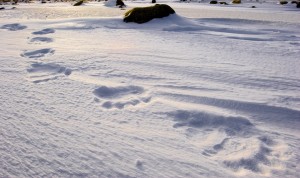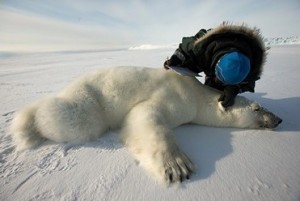Discover the research programme implemented by SPYGEN in collaboration with WWF, LECA*, USGS*, USFWS* and NSB* for the individual monitoring of the polar bear.
The polar bear: a vulnerable species
The polar bear (Ursus maritimus) is the largest land carnivore species. It mainly inhabits the arctic regions and has evolved to occupy a narrow ecological niche, with body characteristics adapted to cold climate. Being at the top of the food chain, this carnivore is a sensitive indicator of the ecosystem health and can help us understand what is happening in the Arctic; a population of polar bears in decline may signal a wider dysfunction in the arctic marine ecosystem. The polar bear is listed on the IUCN Red List as Vulnerable, with 8 of the 19 world populations in decline. Today, the polar bear is primarily threatened by loss of habitat due to climate change and ice melting.
A species difficult to study
In a constantly changing environment, such as the Arctic, research on polar bears is very complicated and expensive to implement. In fact, bears are dispersed in large habitats and therefore difficult to locate. Individual monitoring methods that are currently used require immobilization of the animal from a helicopter. This type of monitoring does not provide enough data to understand the habitat needs and population dynamics, and thus to enable sustainable management of the species. Non-invasive monitoring, based on the collection of hair or faeces left by the animal in the field, has also been implemented for the polar bear. However these samples are still very difficult to find, hampering their collection at a large scale.
An innovative approach to help conserving the polar bear
 In 2014, SPYGEN and WWF have established a research programme to develop an alternative method for species monitoring: the individual identification of polar bears from DNA left in the footprints. Indeed, bear footprints are probably the most abundant clues found in the field. The possibility of identifying an individual with this new approach could revolutionise the monitoring and management of bear populations. Data collection would be greatly facilitated over current field methods and could be carried out over the entire arctic region by local populations (including the Inuit). Obtaining genotypes from snow samples over several years would enable the assessment of population genetic parameters such as relatedness between individuals, and gene flow, but also the estimation of demographic parameters and population characteristics such as population size and growth rate, dispersion, etc. If the results of this programme are conclusive, this approach could then be proposed for monitoring other rare species living in similar ecosystems.
In 2014, SPYGEN and WWF have established a research programme to develop an alternative method for species monitoring: the individual identification of polar bears from DNA left in the footprints. Indeed, bear footprints are probably the most abundant clues found in the field. The possibility of identifying an individual with this new approach could revolutionise the monitoring and management of bear populations. Data collection would be greatly facilitated over current field methods and could be carried out over the entire arctic region by local populations (including the Inuit). Obtaining genotypes from snow samples over several years would enable the assessment of population genetic parameters such as relatedness between individuals, and gene flow, but also the estimation of demographic parameters and population characteristics such as population size and growth rate, dispersion, etc. If the results of this programme are conclusive, this approach could then be proposed for monitoring other rare species living in similar ecosystems.
*LECA: Laboratoire d’Ecologie Alpine (France); USGS: United States Geological Survey (USA); USFWS: United States Fish and Wildlife Service (USA); NSB: North Slope Borough Department of Wildlife Management (USA)
Programme news:
September 2014: WWF International – Arctic expedition pioneers technique for polar bear research;
September 2014: Scientific American – Polar Bear DNA Found from Tracks in Snow in Conservation Step;
March 15: Launch of the 2015 field session for samples collection in Alaska;


